Research Impact and Knowledge Exchange
Our research impact and knowledge exchange work makes our research accessible to a wider non-academic audience. Our researchers engage with audiences outside of academia regionally, nationally, and internationally, operating across a variety of different domains – in public policy; the heritage sector; the arts and culture; business, trade unions and NGOs; and more generally as key voices in public debate. The Oxford History Faculty is characterised by its enormous intellectual diversity and breadth – and our knowledge exchange and impact activity reflects this commitment to pluralism as we have built external relationships across a range of different sectors.
Here are some examples of recent projects that showcase this aspect of the Faculty’s work.
Case Study: Jewish Country Houses – Objects, Networks, People
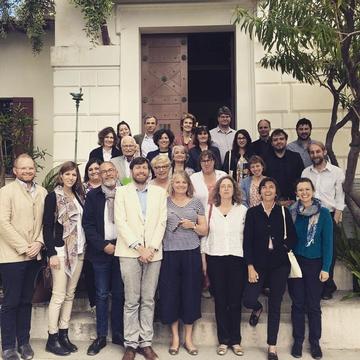
The European network launch at Villa Kerylos
Jewish Country Houses is a major 4-year research project funded by the Arts and Humanities Research Council, commencing in October 2019. The project is a collaboration between the Universities of Oxford, Durham and Cardiff and involves intensive work with heritage partners in the UK and continental Europe.
Knowledge-Exchange with the Heritage sector lies at the heart of this project, which cuts across existing paradigms in Jewish history and country house studies, and seeks to establish the Jewish Country House as a focus for scholarly research, a site of European memory and a significant aspect of European Jewish heritage. The project has been incubated by Professor Abigail Green over four years in conversation with curators at Strawberry Hill House and Waddesdon Manor and through a series of Knowledge Exchange Fellowships held at TORCH in partnership with the National Trust, Historic England and the European Association for the Preservation and Promotion of Jewish Culture and Heritage (AEPJ).
While some of our activities are geared towards specialist research, others are co-designed with project partners with significant potential public benefit – locally, nationally and internationally.
Locally, our activities range from fostering the work of community action groups like the Worth Park History Society, through providing site-specific volunteer training in Jewish history, culture and identity at historic houses like Upton House and Nymans, to supporting the work of under-resourced properties like Salomons Estate and Gunnersbury Park by integrating them into broader networks, and in other ways. In this context, we are developing a mobile exhibition produced in partnership with J-Trails, that will provide a focus and a mechanism for engaging with the great tradition of research into the deep and wide histories of localities and places that exists outside formal academic structures.
At national level, we are working closely with the National Trust – a key project partner – to create a paradigm of ‘best practice’ in the heritage sector, derived from project work at 7 key properties that collectively attract over a million visitors. This work involves creating practical resources, like a resource pack for NT staff, facilitating NT participation at project workshops and conferences (which benefit from additional NT sponsorship), and mentoring NT curators on an ongoing basis. This has already led to a variety of Jewish-themed activities at NT properties, for instance through participation in the annual UK Jewish Heritage Days. We can already see how exhibitions like ‘Disraeli the Other’ at Hughenden Manor are feeding into more substantial curatorial reinterpretation.
Internationally, we are working against the grain of nationally-constructed heritage cultures to foster relevant pan-European relationships. This activity is central to the project because Jewish country houses cannot be interpreted or understood without reference to the broader European context. In partnership with the AEPJ, we are developing a pan-European network that will feed into a ‘Palaces, Villas and Country Houses’ theme within the Jewish Cultural Route managed by the AEPJ and accredited by the Council of Europe, with both scholarly and touristic dimensions. This dimension of the project involves building close partnerships with the Centre des Monuments Nationaux (France), which hosted the network launch at Villa Kerylos, and with individual properties like the Château de Seneffe (Belgium), Villa Stiassni (Czech Republic), the Musée Camondo (France), and the Villa Montesca (Italy). Working with the international arts consultancy Urkultur to commission a new body of work by the prize-winning architectural photographer Hélène Binet is a further way of reinforcing connections across properties and engaging new publics with this rich and diverse project.
Case Study: Learning From Financial Crises
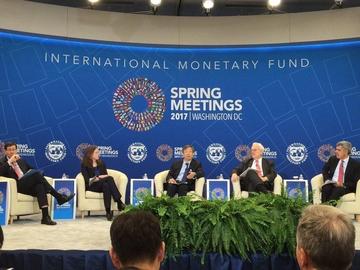
Catherine Schenk at the International Monetary Fund Spring Meetings in Washington DC in 2017. The theme of the panel was ‘The Future of the SDR’ and she was invited to contribute how the past could be used in this broader discussion. (Left to Right: Maurice Obstfeld (IMF Chief Economist), Catherine Schenk, Yi Gang (now Governor of the People’s Bank of China), Jose Maria Ocampo (Board of Governors of Central Bank of Colombia), Mohamed A. El-Erian (Chief Economic Advisor at Allianz))
The recurring nature of financial crises has prompted public and policy interest in understanding historical episodes, both to learn from the past and also to understand the influence of the distinctive historical environments of previous crises. This public and policy interest was renewed after the 2007-2008 global financial crisis and its aftermath. As part of the increased appetite for the ‘long view’ of international economic relations, Professor Catherine Schenk’s work on international monetary cooperation has contributed to debates over how to respond to global economic challenges within institutions such as the International Monetary Fund and the Bank for International Settlements. For example, she was an advisor for an IMF investigation on how the Fund’s unit of account, the Special Drawing Right (SDR), might be revitalised to resolve imbalances in the global monetary system. Professor Schenk’s historical research (Schenk 2010) had shown that the SDR was an awkward and technical instrument, which from its origins was a triumph of compromise over clarity. This made it a poor basis for reforming the international monetary system. The resulting report was discussed by the IMF Executive Board and its recommendation that the prospects for reforming the SDR were not promising, was accepted. [https://www.imf.org/en/Publications/Policy-Papers/Issues/2018/04/11/pp030618consideration-of-the-role-the-sdr]
For the IMF’s Independent Evaluation Office, Professor Schenk drew on her historical work to assess how successfully the IMF fulfilled its duty to promote international monetary cooperation since the Global Financial Crisis. Her background paper contributed to a wide-ranging review of the IMF’s policies and practices by the Executive Board. [https://ieo.imf.org/en/our-work/Evaluations/Completed/2019-0614-unconventional-monetary-policy]
Professor Schenk’s appointment as Senior Lamfalussy Fellow at the Bank for International Settlements (www.bis.org) in 2019 signified how the BIS had also come to value the importance of historical reflections on current policy issues. While there she worked with economic policy staff, in particular exploring how central bank cooperation in the mid-20th century offered a closer model for the response to the 2008 crisis than had been previously understood. This research emphasizes the continuity in the motivation for central bank cooperation while also pointing out how the historic examples were embedded in wider structures that formed an elaborate global financial safety net. Reflecting on the past encourages a reassessment of the current global financial safety net.
Professor Schenk has also shared her research with a range of other policy audiences, including addressing the United Nations and participating in seminars with central bankers including the Bank of England, Swiss National Bank, Bundesbank, Hong Kong Monetary Authority and the Bank of Japan as well as the UK Foreign Office. She is an Associate Fellow, Global Economy and Finance at Chatham House, a leading international think tank.
BIS Podcast: ‘Catherine Schenk on why history matters for current economic events and policymaking’
BIS Video explaining what Catherine Schenk did at the BIS
Schenk (2010), The Decline of Sterling; managing the retreat of an international currency 1945-1992, Cambridge.
Case Study: Housing, Culture and Women’s Citizenship in Britain
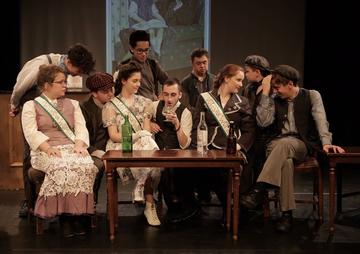
Image from 'It’s the Wrong Way to Tickle Mary'
(c) Shay Rowan
Housing, Culture and Women's Citizenship in Britain, c.1945 to the present was an AHRC Follow-on and John Fell Fund-funded project examining working-class women’s lives, which ran between February 2018 and June 2019 and was led by Professor Selina Todd. This work built on the earlier AHRC-funded project Feminism, Culture and Women’s Lives in Britain, c.1945-c.2015 (2017), also led by Professor Todd, which focused on the life and work of the playwright Shelagh Delaney to examine the role of the cultural sector in introducing and disseminating feminist ideas, and on the role of women as pioneers of artistic and social change.
During both projects, historical research was drawn upon in the development of community theatre with project partners based in Manchester and Salford, enabling young people and women and men across a wide age range to develop their confidence, performance skills, and historical interest in the region.
Todd’s biography of Shelagh Delaney, the Salford-born author of ground-breaking play A Taste of Honey, was the starting point for exploring the playwright’s further body of work and the economic, social and cultural contexts in which it was created. In order to explore Delaney’s work with local communities in Greater Manchester, Todd and Dr Andrea Thomson (Research Associate) collaborated with MaD Theatre Company, writer Charlotte Delaney, the Working Class Movement Library and the Guinness Partnership (affordable housing registered provider).
MaD Theatre Company describe themselves as ‘aiming to do theatre by and for people who wouldn’t normally go’ and provide interactive drama workshops for young people and adults around Greater Manchester, enabling them to gain performance skills, increase their confidence and self-esteem, and boost their education and employment opportunities.
The initial AHRC funding enabled MaD to work with the project team to reach out and engage with local young people and adults to develop and perform the play. The Guinness Partnership, which manages recently refurbished tower block Delaney Heights, named after Shelagh Delaney, provided office space and project support, while Charlotte Delaney (Shelagh’s daughter) adapted the three-part radio play Sweetly Sings the Donkey for the stage.
The play was performed by the Delaney Theatre Group at the Lowry Theatre, Salford, in October 2017, selling out its two-night run and playing to enthusiastic audiences. As well as enjoying the quality of the production, many people observed that seeing the play would encourage them to look out for similar theatre productions in the future, even though they were not regular theatre-goers.
A second play, funded through AHRC and Oxford University’s John Fell Fund, was created by MaD in 2018, in close collaboration with members of the Delaney Theatre Group. Set around 1918, It’s the Wrong Way to Tickle Mary was performed to packed and appreciative audiences at the Lowry Theatre, the Met Theatre (Bury), Rochdale Literature & Ideas Festival, and Salford Arts Theatre in autumn and winter 2018/2019.
The play (whose title is a reference to a popular take on contemporary song It’s a Long Way to Tipperary) looks at the war through the lens of class, gender and the experience of women, offering participants and audiences new insights into this period. In particular, it explores how women’s wartime experiences contributed to subsequent suffrage campaigns and considers whether life has changed for the better for working-class communities in Greater Manchester in 2019.
Professor Todd comments: ‘Both Sweetly Sings the Donkey and It’s the Wrong Way to Tickle Mary demonstrated to new audiences the relevance of historical events and experiences in an engaging, highly effective way. Many of the themes explored – including poverty and inequality – remain social issues affecting communities in Greater Manchester and the wider north-west today’.
Rob Lees, Artistic Director of MaD Theatre Company, added: ‘Working with the Oxford historians allowed real-life historical settings and experiences to become the inspiration for storylines, characters and dialogue developed by the group and allowed audiences to see many of their own contemporary feelings and experiences reflected onstage. MaD is now planning further performances using modern history as a starting point’.
For further information about these projects:
Housing, Culture and Women's Citizenship in Britain, c.1945 to the present
Selina Todd, Tastes of Honey: The Making of Shelagh Delaney and a Cultural Revolution (Chatto & Windus, 2019)
The Feminism, Culture and Women’s Lives in Britain, c.1945-c.2015 project was featured on BBC News North West in August 2017
Case Study: The Centenary of Women’s Suffrage

The centenary of women’s suffrage in 2018 presented a wonderful opportunity for post-holders and postgraduates in Oxford to link our research to a wider national programme of feminist scholarship, activism and outreach. Led by Irish historian Professor Senia Paseta, we were especially keen to ensure that distinctive national and regional experiences of the women’s suffrage movement were explored and highlighted in their local contexts. We were also eager to take advantage of the suffrage centenary to think more broadly about developments and opportunities within women’s history and how they could be communicated to wider audiences.
Planning for the centenary began long before 2018 as Professor Paseta worked with colleagues on a series of events and initiatives. The most ambitious was a major exhibition, Sappho to Suffrage: Women Who Dared, which Professor Paseta curated, planned and organised with colleagues in the Bodleian Library. The exhibition’s main aim was to show items from the Bodleian’s holdings which were made, written or commissioned by women over several hundred years. The point was not to display only very famous items such as a prayer book made by Elizabeth I or Jane Austen’s notebooks, though these were important in establishing the breadth of women’s achievements in the past. We were more concerned with exhibiting a selection of women-centred items which had never before been displayed in this thematic format, and therefore to alert visitors to new research possibilities and to contribute to development of women’s studies in the University and beyond.
The exhibition was not primarily about women’s suffrage, though several cases in the Treasures Gallery contained a range of intriguing suffrage items.
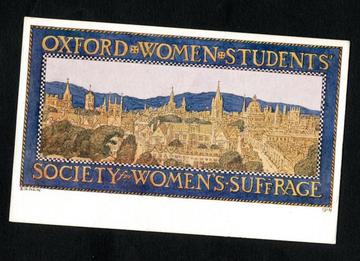
Bodleian Libraries, University of Oxford: John Johnson Collection; Postcards 12 (406)
Because we wanted to work with the exhibition to support knowledge exchange, we created a number of new resources which highlighted Oxford’s particular suffrage movement, a movement which was embedded in the city and the university in the early twentieth century. These included a downloadable timeline and short histories of the women’s suffrage movement in Oxford:

They also included two new displays for the exhibition, both commissioned and created by women. The first was the ‘lost’ Oxford suffrage banner carried by an Oxford contingent at a national suffrage march in London in 1908 and recreated in 2018. This became a symbol of Oxford’s centenary year, featuring on postcards, badges, flags and in the press. The flags will continue to be flown in Oxford to commemorate women’s history month in future years.
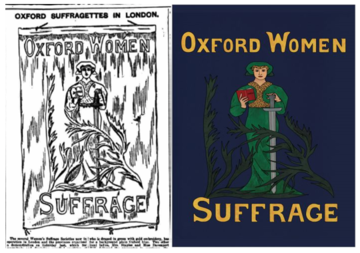
The second was our modern suffrage wall, displayed in the Gallery and online and featuring women from around the UK representing a variety of occupations from within the Arts, Business, Education, Politics, Science and Sport. This display of modern suffrage champions mirrored the exhibition’s postcard display of the original suffragists, encouraging visitors to reflect on continuity and change.
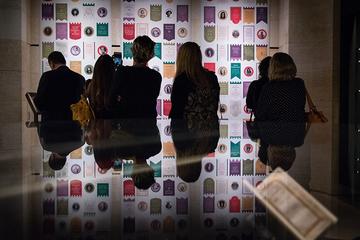
Other highpoints from the year included panel discussions, an international women’s suffrage conference, and the preview of Charlotte Delany’s play, The Only Way is Suffrage, at the Burton Taylor Studio. We were also delighted to work with GLAM (University Gardens, Libraries and Museums) which created Shout Out for Women, a trail created to mark the 100th anniversary of the Representation of the People Act 1918 and featuring work created by women across the university’s collections.
Sappho to Suffrage ran from March 2018 until February 2019, attracting around 164,000 visitors and acting as a focus for a number of initiatives. These included events for families and children in the Bodleian and Suffrage in a Box, a teaching resource which included reproductions of items from the Bodleian’s collections relating to women’s suffrage:





